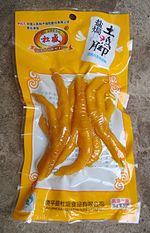- Vacuum packing
-
 Salt-baked chicken feet sold in China: vacuum-packed and ready to eat
Salt-baked chicken feet sold in China: vacuum-packed and ready to eat
Vacuum packing or vacuum packaging is a method of packaging that removes air from the package prior to sealing. It can involve both rigid and flexible types of packaging. The intent is usually to remove oxygen from the container to extend the shelf life of foods and, with flexible package forms, to reduce the volume of the contents and package.[1]
The vacuum environment reduces atmospheric oxygen, limiting the growth of aerobic bacteria or fungi, and preventing the evaporation of volatile components. Vacuum packing is commonly used for long-term storage of dry foods such as cereals, nuts, cured meats, cheese, smoked fish, coffee, and potato chips (crisps). It is also for storage of fresh foods such as vegetables, meats, and liquids such as soups in a shorter term because vacuum condition cannot stop bacteria from getting water which can promote their growth.
Vacuum packing is also used to reduce greatly the bulk of non-food items. For example, clothing and bedding can be stored in bags evacuated with a domestic vacuum cleaner or a dedicated vacuum sealer. This technique is sometimes used to compact household waste, for example where a charge is made for each full bag collected.
Vacuum packaging products using plastic bags, canisters, bottles, or mason jars are available for home use.
Vacuum packaging delicate food items can be done by using an inert gas, such as nitrogen. This helps prevent crushing fragile items and delicate foods such as potato chips.
Contents
External sealers
External vacuum sealers involve a bag being attached to the vacuum-sealing machine externally. The machine will remove the air and seal the bag, which is all done outside the machine.
Chamber sealers
Chamber sealers require the entire product to be placed within the machine. Like external sealers, a plastic bag is typically used for packaging. Once the product is placed in the machine, the lid is closed and air is removed. Once the air is removed, the bag is sealed and the atmosphere within the chamber is returned to normal. The lid is then opened and the product removed. Chamber sealers are typically used for higher-volume packaging.
Preventing freezer burn
When foods are frozen without preparation, freezer burn can occur. It happens when the surface of the food is dehydrated, and this leads to a dried and leathery appearance. Freezer burn also ruins the flavor and texture of foods. Vacuum packing reduces freezer burn by preventing the food from exposure to the cold, dry air.
Sous-vide cooking
Vacuum packaging also allows for a special cooking method, sous-vide. Sous-vide, French for under vacuum, involves poaching food that is vacuum sealed in a plastic bag.
Food safety
In an oxygen-poor environment, Anaerobic organisms can proliferate, potentially causing food safety problems. Vacuum packing is often used in combination with other packaging and food processing techniques.
References
- ^ Soroka, W. Illustrated Glossary of Packaging Terminology (Second ed.). Institute of Packaging Professionals. http://www.iopp.org/i4a/pages/Index.cfm?pageID=1.
Books
- Yam, K. L., "Encyclopedia of Packaging Technology", John Wiley & Sons, 2009, ISBN 978-0-470-08704-6
Food preservation Biopreservation · Canning · Cold chain · Curing · Drying · Fermentation · Freezing · Freeze drying · Hurdle technology · Irradiation · Jamming · Jellying · Jugging · Modified atmosphere · Pickling · Potting · Pressure · Salting · Smoking · Sugaring · Vacuum packingCategories:- Food preservation
- Vacuum
- Packaging
Wikimedia Foundation. 2010.
